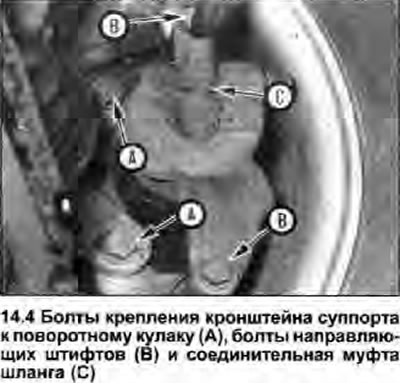Note: Please refer to the note given at the beginning of the Chapter 9 and the warning given at the beginning Chapter 13 (regarding asbestos dust).
Removing
1. Jack up the front of the vehicle, place it securely on axle stands, then remove the wheel.
2. Minimize fluid loss. To do this, remove the cover of the main cylinder feed tank and tighten it again by placing a piece of polyethylene under the cover (do not damage the level sensor). This will give an airtight seal and prevent liquid from spilling. Alternatively, pinch the hose using a hose clamp, clamp, or similar tool.
3. Clean the surrounding area, then loosen the hose coupler.
4. Turn off two bolts of fastening of an arm of a support to a rotary fist (see photo).

5. Remove the brake caliper assembly and push in a clean wooden brace (the same thickness as the brake disc) between the brake pads to secure them.
6. Unscrew the caliper from the hose coupling. If a sealing washer is used at this joint. discard it - such washers should be replaced after each removal. If the caliper will not disassemble, plug its hole to prevent dirt from entering; also plug the hose connector (or wrap it tightly with polyethylene).
Installation
7. Install in the reverse order of removal paying attention to the following:
- a) Tighten all nuts and bolts with a tightening torque specified specifications.
- b) If so, be sure to replace the sealing washer on the hose coupling.
- c) Make sure the hose is securely clamped onto the caliper and that it is properly routed, not kinked, and secured with a clamp.
- d) Bleed the system (see chapter 9). Check component joints for leaks.
